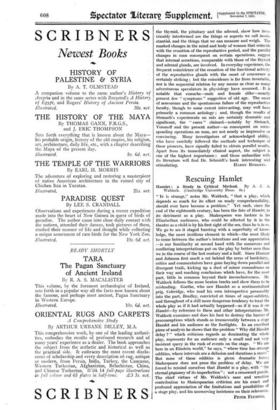Is Old Age Avoidable ?
TEN years ago, Steinach said : I think the day will come 'hen vaso-ligature, or some other process having a like effect., will be undertaken by the State for every man of fifty, just as every child is vaccinated for the prevention of smallpox to-day." Should this prophecy be fulfilled, one wonders if this piece of therapy would gradually drop out of fashion, as vaccination against smallpox is tending to do in many countries where it was once universal. Dr. Schmidt is one of Steinach's most enthusiastic disciples ; and in this book he presents, as much for the information of the layman as of the doctor, the case for, and the evidence in support of, the theory that old age is essentially a functional failure of the interstitial cells associated with the glands of reproduction. What is known as the Steinach operation aims at the re-stimulation of these cells so that, once again, they may furnish the blood with their youth-preserving product.
The life of a multi-cellular organism is dependent on the continued vitality of its individual cells, or of their continued proliferative capacity, and also on the maintenance of that intercellular communication and co-ordination which make possible physiological balance and harmony. What is it that in every known animal and plant fixes (according to all previous experience) a measurable temporal limit to growth and to life ? What is it, again, that gives to each of the halves of the fissured amoeba, as to the fertilized ovum, a new lease of existence ; rendering us all—amocha and man alike—" ins mortal through our descendants " ? Is the secret of senescence —and therefore of rejuvenescence—hidden in . the realni into which mystics and theologians try to peep ; or is it within the more clearly defined, if more artificial, world in which the physical scientists disport themselves ? We know, from the experiments of Carrel and others, that the senescence of cells and homocellular tissues can be almost indefinitely postponed by attention to the medium—the artificial plasma—in which they are cultiVated. This does not, however, apply to those master nerve-cells (incapable of reproducing themselves even within the living body) on which that co-ordination, which is of the very essence of our being, so largely depends. Whilst senescence in a complex organism, such as man, is not explained by these experiments in tissue culture, we shall be wise to refrain, in the absence of adequate plumb-lines, from classing it as an unfathomable mystery. .
The important parts played, not only in, our physical, but no less in our psychic, life by the secretions of such glands as
the thyroid, the pituitary and the adrenal, show how inex- tricably intertwined are the things or aspects we call insub- stantial, and the things that we can measure and weigh. The marked changes in the mind and body of woman that coincide with the cessation of the reproductive period, and the parallel changes in man consequent on certain operations, suggest that internal secretions, comparable with those of the thyroid and adrenal glands, are involved. In everyday experience, the frequent coincidence of the cessation of the functional activity of the reproductive glands with the onset of senescence is certainly striking ; but the coincidence is far from invariable, nor is the sequential relation by any means as clear as many adventurous speculators in physiology have assumed. = It is notable that eunuchs—male and female alike—usually present few " symptoms " suggestive of old age. The onset of senescence and the spontaneous failure of the reproductive faculty, though to some extent inter-acting, may well have primarily a common aetiology ; and, though the results of Steinach's experiments on rats are certainly dramatic and significant, the cures " claimed—notably by Steinach, Voronoff and the present author—as consequent on corre- sponding operations on man, are not nearly so impressive or convincing. Many investigators of acknowledged ability, who have carefully followed the methods and technique of these pioneers, have signally failed to obtain parallel results. Apart from its immediately clinical aspect, the subject is one of the highest importance ; and those unfamiliar with its literature will find Dr. Schmidt's book interesting and















































 Previous page
Previous page